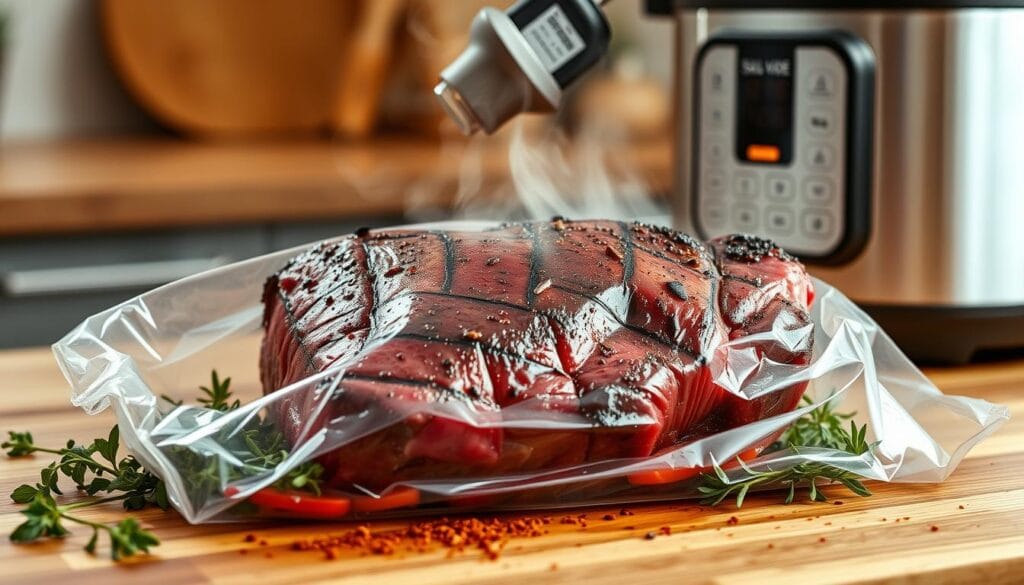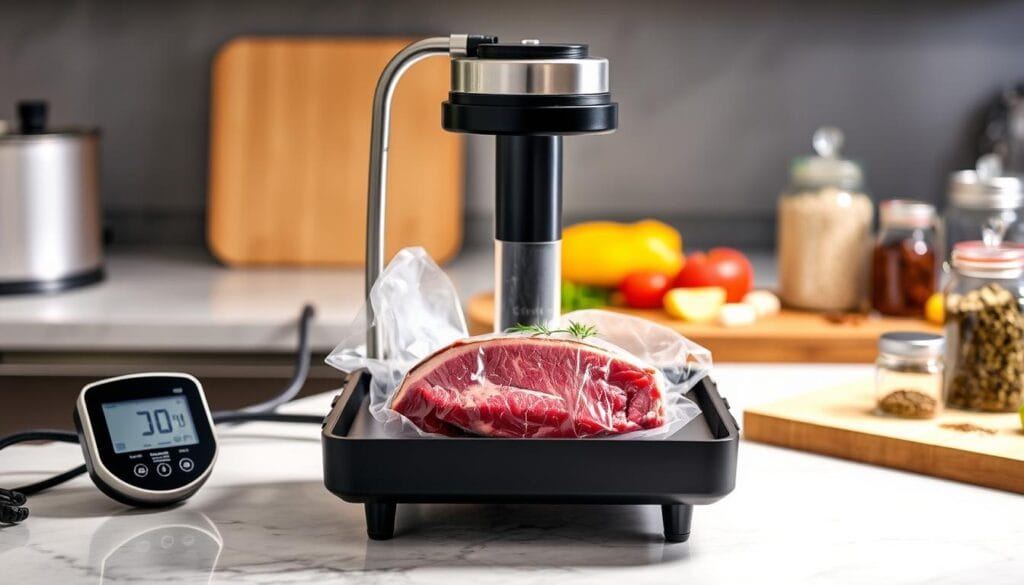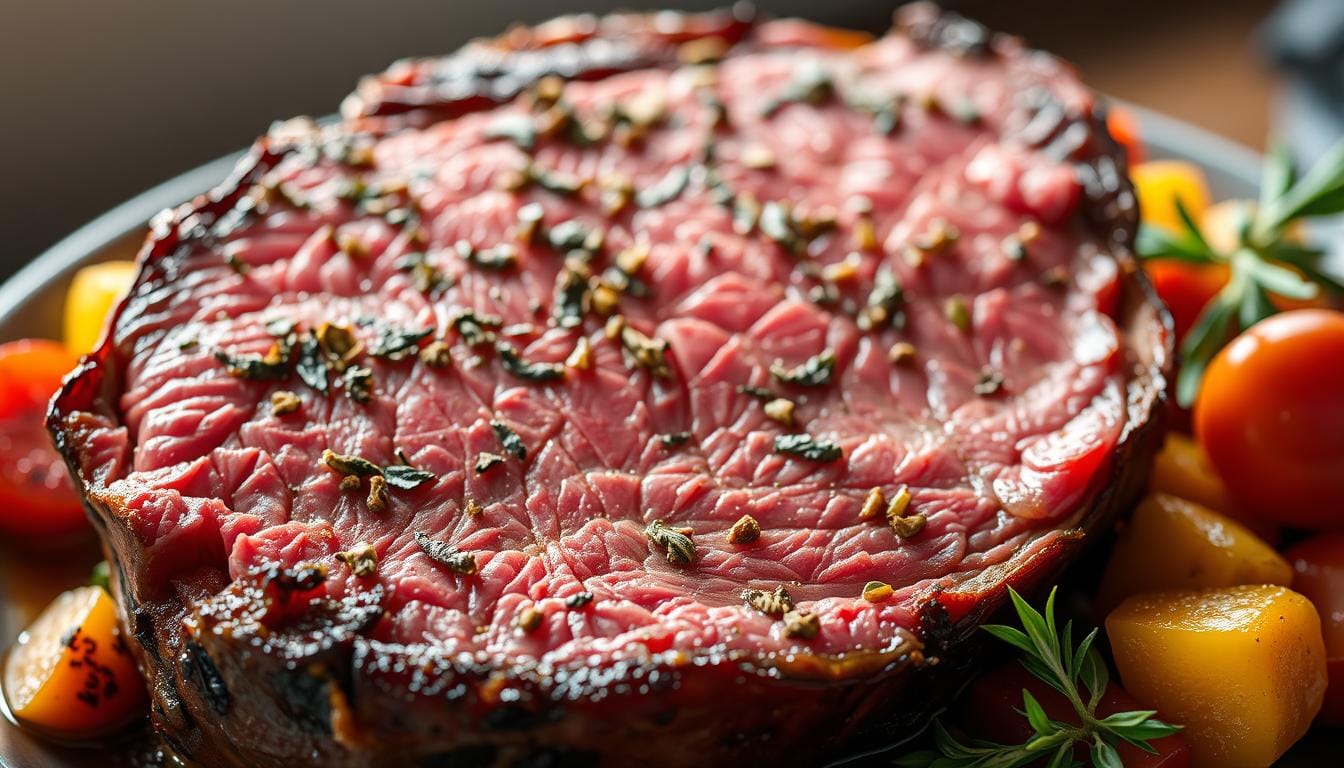Imagine a ribeye roast so tender, it melts in your mouth. Every bite is like a taste from a fancy restaurant. As someone who’s struggled with unpredictable ovens, I found sous vide cooking. It turns a simple ribeye roast into a masterpiece.
Cooking sous vide is more than a method; it’s a precise art. It ensures your roast is always perfect. This technique will make you a better cook, impressing everyone who tries your dish.
Think about serving a roast so tender, it wows your guests. Sous vide makes this dream come true. Get ready to make the most delicious ribeye roast you’ve ever had.
Key Takeaways
- Sous vide ensures perfectly consistent meat doneness every time
- A 3-pound ribeye roast is ideal for most home cooking situations
- Precise temperature control eliminates the risk of overcooking
- The technique works for both novice and experienced cooks
- Sous vide delivers restaurant-quality results in your own kitchen
Table of Contents
Understanding Sous Vide Rib Eye Roast

Sous vide cooking changes how you make a perfect ribeye roast. It brings precision and consistency to your kitchen. This means every slice of meat is cooked just right.
What Makes Sous Vide Perfect for Rib Eye
Sous vide cooking lets you control the cooking of your ribeye roast like never before. It cooks the meat evenly, making it tender and juicy. This is hard to get with traditional cooking methods.
- Precise temperature control
- Consistent doneness throughout the roast
- Retention of natural meat juices
Benefits of Sous Vide Cooking Method
Choosing sous vide for your ribeye roast brings many benefits. The slow cooking breaks down tough meat fibers. This makes the meat tender and delicious.
“Sous vide is like a time machine for cooking – it transforms tough cuts into restaurant-quality masterpieces.”
Science Behind the Technique
The science of sous vide cooking is all about temperature control. Two meat enzymes, calpains and cathepsins, are key to tenderizing the roast:
- Calpains stop working at 105°F (40°C)
- Cathepsins keep working until 122°F (50°C)
Keeping the water bath at 136°F (58°C) is perfect for these enzymes. This can take up to 5 hours. It turns your ribeye into a very tender piece of meat.
Essential Equipment and Tools
Mastering sous vide recipes needs the right tools for perfect results. Quality equipment makes your cooking better and lets you make restaurant-quality meals at home.

- Sous vide immersion circulator
- Large cooking container or pot
- Vacuum sealer or high-quality zipper bags
- Digital food thermometer
- Precision kitchen scale
“The right tools make sous vide cooking both precise and enjoyable.” – Professional Chef
When picking your sous vide gear, think about these important points:
| Equipment | Key Features to Consider | Price Range |
|---|---|---|
| Immersion Circulator | Temperature accuracy, water circulation power, noise level | $100-$300 |
| Vacuum Sealer | Sealing strength, bag compatibility, ease of use | $50-$200 |
| Cooking Container | Size, heat resistance, insulation | $30-$100 |
Optional accessories can improve your sous vide cooking. Sous vide weights keep bags down, and silicone clips hold bags in place. These tools are not must-haves but can make cooking easier and more consistent.
Quality is key in sous vide cooking. Good equipment ensures you get perfect meals every time.
Selecting the Perfect Rib Eye Roast
Choosing the right ribeye roast is key for a great sous vide steak. The roast you pick will affect the taste, tenderness, and quality of your dish.
Bone-in vs Boneless Options
You’ll find two main types of ribeye roast: bone-in and boneless. Each type has its own benefits for your sous vide rib eye roast:
- Bone-in roasts add more flavor
- Boneless roasts are easier to carve and prepare
- Bone-in cuts need careful bag sealing to avoid leaks
Quality Grades and Marbling
Understanding beef quality grades is important for the best ribeye roast. USDA grading helps you know the meat’s quality:
| Grade | Marbling | Flavor Potential |
|---|---|---|
| Prime | Abundant | Exceptional |
| Choice | Moderate | Very Good |
| Select | Minimal | Good |
Size Considerations
Choosing the right roast size is important for perfect portions and cooking. Here are some tips for your sous vide steak:
- Bone-in roast: 5 pounds (serves 6-8 people)
- Boneless roast: 3 pounds (serves 6-8 people)
- Recommended portion: 0.5 pounds per guest
“The secret to an extraordinary roast begins with selecting the right cut.” – Professional Chef
Your choice of ribeye roast is the start of an amazing sous vide cooking journey. Look at marbling, think about bone-in or boneless, and pick a size that fits your event.
Preparing Your Roast for Sous Vide
Getting your rib eye roast ready for sous vide cooking is all about the details. Your prep work will make your meal tender and full of flavor. Start by picking a top-notch cut of meat with lots of marbling.
- Trim excess fat, leaving a ¼ to ½ inch fat cap for optimal flavor
- Pat the meat completely dry with paper towels
- Season generously with kosher salt and freshly ground black pepper
- Consider adding fresh herbs like rosemary or thyme for extra depth
“The key to great sous vide cooking is precise preparation and seasoning.” – Professional Chef
When you’re sous vide cooking, focus on your seasoning. Sous vide lets seasonings get into the meat better than regular roasting. Try making a dry rub to boost the rib eye’s natural taste.
Pro tip for sous vide cooking: If you can, let the seasoned roast chill in the fridge for 1-2 hours before cooking. This lets the salt make the meat more flavorful and tender.
| Preparation Step | Time Required |
|---|---|
| Trimming | 5-10 minutes |
| Seasoning | 3-5 minutes |
| Refrigerator Rest | 1-2 hours (optional) |
Remember, getting your sous vide cooking right is all about the prep. Take your time, be precise, and you’ll get a roast that’s restaurant-quality, cooked perfectly all the way through.
Optimal Temperature and Time Settings
Mastering sous vide cooking means getting the temperature and timing just right. Your perfect ribeye roast depends on these key factors. Sous vide cooking lets you get consistent doneness with unmatched control.
Temperature Guide for Different Doneness Levels
Choosing the right temperature makes your sous vide rib eye roast truly stand out. Every degree counts in making your meat just right.
| Doneness | Temperature | Texture Description |
|---|---|---|
| Rare | 125°F (52°C) | Cool red center |
| Medium Rare | 132°F (55°C) | Warm red center |
| Medium | 140°F (60°C) | Warm pink center |
| Medium Well | 150°F (66°C) | Slight pink center |
Cooking Duration Guidelines
Your sous vide rib eye roast needs careful timing. Professional chefs suggest 3-5 hours for the best tenderness in your ribeye roast sous vide.
- Minimum cooking time: 3 hours
- Optimal cooking time: 4-5 hours
- Maximum recommended time: 8 hours
Pro tip: Longer cooking times break down connective tissues, resulting in incredibly tender meat.
When making your perfect ribeye roast, remember that precise temperature control is crucial. It’s the secret to achieving restaurant-quality results every time.
Seasoning and Aromatics
Creating a great ribeye roast recipe starts with picking the right seasonings and aromatics. Your sous vide recipes need careful attention to flavor and food safety.
When you’re getting ready to season your ribeye roast, keep these tips in mind:
- Use fresh herbs like thyme and rosemary for robust flavor
- Create a dry rub with sea salt and black pepper
- Avoid placing fresh garlic directly in the vacuum-sealed bag
“The secret to an exceptional sous vide ribeye is layering flavors without compromising safety.”
For a classic herb butter that makes your ribeye roast recipe stand out, mix:
- 2 tablespoons unsalted butter
- 2 tablespoons Dijon mustard
- 2 tablespoons fresh thyme leaves
- 1 tablespoon minced fresh rosemary
- 1 teaspoon black pepper
Pro tip for sous vide recipes: Use dried herbs or herb-infused oils in your vacuum-sealed bag. This way, you get great flavor without risking bacterial growth.
Don’t forget to massage your seasonings into the meat. This makes sure the flavor spreads evenly. It also helps bring out the natural richness of the ribeye during sous vide cooking.
The Sous Vide Cooking Process
Mastering sous vide cooking for your rib eye roast needs precision and careful prep. The right setup can turn an ordinary cut into a top-notch dining experience.
Water Bath Setup
Creating the perfect water bath is key for sous vide cooking. Follow these steps for successful sous vide rib eye roast prep:
- Select a deep container that can hold enough water for full roast submersion
- Use an immersion circulator to maintain precise temperature
- Fill container with water, leaving enough room for the sealed roast
- Preheat water to your desired doneness temperature (135°F for medium-rare)
Vacuum Sealing Tips
Proper sealing is vital for sous vide recipes. It locks in flavor and ensures even cooking. You have two main methods for sealing your ribeye roast sous vide:
- Vacuum Sealer Method
- Remove excess air completely
- Ensure a tight, leak-proof seal
- Check for any potential punctures
- Water Displacement Method
- Use a high-quality freezer bag
- Slowly lower bag into water to push out air
- Seal just before full submersion
“The key to perfect sous vide cooking is consistent temperature and complete water coverage.” – Professional Chef
| Cooking Method | Temperature | Typical Duration |
|---|---|---|
| Sous Vide Rib Eye Roast | 135°F (Medium-Rare) | 3-8 Hours |
| Immersion Circulator | 132-135°F | 6-10 Hours |
Your focus on detail in the water bath and sealing will ensure a tender, flavorful rib eye roast. It will impress even the most discerning food lovers.
Finishing Techniques and Searing
To turn your sous vide steak into a perfect ribeye roast, you need to master searing. After cooking it to perfection, the last step is to add a golden-brown crust. This crust boosts the meat’s flavor and texture.
Choosing the right searing method is key to a perfect ribeye roast. You can use:
- Cast iron skillet method
- High-temperature oven searing
- Propane torch technique
- Grill finishing
For the best results, heat your oven to 500°F. Make sure to dry your sous vide steak well. A dry surface is essential for a crispy crust.
“The perfect sear transforms a good roast into an extraordinary culinary experience.”
Timing is crucial when searing. You want to expose your steak to high heat for 15-20 minutes. This creates a beautiful crust without losing the tender inside from sous vide cooking.
| Searing Method | Temperature | Duration |
|---|---|---|
| Oven Searing | 500°F | 15-20 minutes |
| Cast Iron Skillet | High Heat | 2-3 minutes per side |
| Propane Torch | Direct Flame | 30-60 seconds |
Pro tip: Let your roast rest for 10-15 minutes after searing. This step helps the juices spread evenly. Your slices will be juicy and full of flavor.
Making the Perfect Au Jus
Creating a delicious au jus can make your ribeye roast truly special. It’s all about using the flavorful liquid from sous vide cooking. Your homemade au jus will turn your ribeye roast into a top-notch meal.
- 3 tablespoons unsalted butter
- ¼ cup minced shallot
- 2 cloves garlic, minced
- ¼ cup dry red wine
- 2 cups beef drippings from sous vide bag
The process is simple and boosts your ribeye roast’s flavor. Begin by cooking shallots and garlic in butter until they’re soft and smell great. Then, add red wine to the pan and let it cook down a bit.
“The secret to a perfect au jus is balancing the rich meat juices with aromatic ingredients.” – Professional Chef
After that, mix in the liquid from your sous vide bag. Strain it to get a smooth sauce that enhances your ribeye roast without overpowering it.
| Ingredient | Quantity | Purpose |
|---|---|---|
| Beef Drippings | 2 cups | Primary flavor base |
| Red Wine | ¼ cup | Adds depth and complexity |
| Butter | 3 tablespoons | Creates richness and smooth texture |
You can make your au jus ahead of time and warm it up just before serving. A tip: Adding fresh herbs like thyme or rosemary during cooking can add even more flavor. This will give you a rich sauce that goes perfectly with your ribeye roast.
Serving and Presentation Tips
To make your sous vide rib eye roast look amazing, focus on serving and presentation. A beautifully presented ribeye roast will wow your guests and make your meal special.
Carving Techniques for Optimal Enjoyment
Carving your sous vide rib eye roast needs precision. Here are some tips for beautiful, tender slices:
- Let the roast rest for 15-20 minutes after cooking
- Use a sharp knife with a long, thin blade
- Slice against the grain into 1/2 to 3/4 inch thick portions
- Remove bone-in sections carefully for easier serving
Plating Suggestions for Visual Appeal
Your sous vide recipes should look as good as they taste. Here are some plating ideas:
- Serve on warmed plates to keep the food hot
- Add fresh herbs like rosemary or thyme for garnish
- Make elegant individual portions or family-style dishes
- Pair with side dishes that complement the flavors
“Presentation is not just about making food look beautiful, but about creating an experience that delights all senses.” – Culinary Expert
| Serving Recommendation | Details |
|---|---|
| Portion Size | 1/2 to 3/4 inch thick slices |
| Resting Time | 15-20 minutes |
| Recommended Sides | Roasted vegetables, mashed potatoes, risotto |
| Garnish Options | Fresh herbs, au jus, compound butter |
By using these serving and presentation tips, you’ll make your ribeye roast a memorable meal. It will show off the amazing results of sous vide cooking.
Storage and Reheating Methods
Keeping your sous vide rib eye roast perfect requires careful storage and reheating. Sous vide cooking is great for keeping meat quality high, even after it’s cooked.
For the best storage, follow these tips:
- Cool the roast completely before storing
- Use vacuum-sealed bags to prevent moisture loss
- Add a small amount of au jus to maintain tenderness
- Refrigerate within 2 hours of cooking
Reheating with sous vide is the most reliable way. Professional chefs say to use water to reheat your roast. This keeps its texture and flavor just right.
Pro tip: Reheat at 132°F for maximum moisture retention and flavor preservation.
How long you need to reheat depends on the roast’s thickness:
| Slice Thickness | Reheating Time |
|---|---|
| 10 mm | 20 minutes |
| 25 mm | 1 hour |
| 50 mm | 3.5 hours |
You can also use an oven at 250°F or an air fryer at 225°F. Make sure the internal temperature hits 165°F for safety. By using these sous vide recipes storage tips, you’ll get a meal that tastes like it’s from a restaurant every time.
FAQ
What is sous vide cooking and why is it ideal for rib eye roast?
What equipment do I need to cook a sous vide rib eye roast?
How do I choose the right rib eye roast for sous vide cooking?
What are the recommended temperatures for different levels of doneness?
How long should I cook a rib eye roast using sous vide?
Do I need to sear the roast after sous vide cooking?
How do I store and reheat leftover sous vide rib eye roast?
Can I use marinades or dry rubs with sous vide cooking?
Conclusion
Learning to cook a sous vide rib eye roast takes your home cooking to the next level. It lets you control the temperature and keep the meat moist. This way, you can make meals that taste like they’re from a restaurant.
Preparing the best ribeye roast is more than just cooking. Sous vide helps you keep more of the meat, reducing waste. It also lets you cook it to the perfect doneness every time, without any guesswork.
But cooking with sous vide is just the start. It opens up a world of possibilities with different meats. You can try new things and grow your cooking skills. It’s not just about cooking; it’s about creating a special experience with every meal.
If you love to cook or want to become a chef, sous vide is a great tool. It makes it easy to create amazing meals that everyone will love. Learning these techniques will make your cooking better and impress your family and friends.

